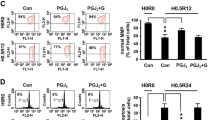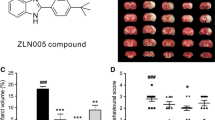Abstract
The peroxisome proliferator activated receptor coactivator 1 alpha (PGC-1α) is a nuclear transcriptional coactivator that is widely expressed in the brain areas. Over-expression of PGC-1α can protect neuronal cells from oxidant-induced injury. The purpose of the current study is to investigate the role of PGC-1α in the oxygen (anoxia) deprivation (OGD) neurons. The PGC-1α mRNA and protein level between control and OGD neurons were examined by real-time PCR and Western blot. More PGC-1α expression was found in the OGD neurons compared with the normal group. Over-expression of PGC-1α suppressed cell apoptosis while inhibition of the PGC-1α expression induced cell apoptosis in OGD neurons. Furthermore, increase of PGC-1α resulted in activation of N-methyl-d-aspartate (NMDA) receptor, p38, and ERK mitogen-activated protein kinase (MAPK) pathway. The blocking of the NMDA receptor by its antagonists MK-801 reduced PGC-1α mRNA expression in OGD neurons, while NMDA itself can directly induce the expression of PGC-1α in neuronal cells. At the same time, PD98059 (ERK MAPK inhibitor) and SB203580 (P38 MAPK inhibitor) also prevented the up-regulation of PGC-1α in OGD neurons and MK801 can inhibit the expression of P38 and ERK MAPK. These data suggested that the expression of PGC-1α was up-regulated in OGD mice cortical neurons, which protected the neurons against OGD injury. Moreover, this effect was correlated to the NMDA receptor and the ERK and P38 MAPK pathway. The protective effect of PGC-1α on OGD cortical neurons may be useful for stroke therapy.




Similar content being viewed by others
References
Ankarcrona, M., Dypbukt, J. M., Bonfoco, E., Zhivotovsky, B., Orrenius, S., Lipton, S. A., et al. (1995). Glutamate-induced neuronal death:a succession of necrosis or apoptosis depending on mitochondrial function. Neuron, 15(4), 961–973. doi:10.1016/0896-6273(95)90186-8.
Borniquel, S., Valle, I., Cadenas, S., Lamas, S., & Monsalve, M. (2006). Nitric oxide regulates mitochondrial oxidative stress protection via the transcriptional coactivator PGC-1 alpha. The FASEB Journal, 20(11), 1889–1891. doi:10.1096/fj.05-5189fje.
Choi, D. W., & Rothman, S. M. (1990). The role of glutamate neurotoxicity in hypoxic-ischemic neuronal death. Annual Review of Neuroscience, 13, 171–182. doi:10.1146/annurev.ne.13.030190.001131.
Dayanithi, G., Rage, F., Richard, P., & Tapia-Arancibia, L. (1995). Characterization of spontaneous and N-methyl-D-aspartate-induced calcium rise in rat cultured hypothalamic neurons. Neuroendocrinology, 61(3), 243–255. doi:10.1159/000126846.
Dirnagl, U., Iadecola, C., & Moskowitz, M. A. (1999). Pathobiology of ischaemic stroke:an integrated view. Trends in Neurosciences, 22(9), 391–397. doi:10.1016/S0166-2236(99)01401-0.
Feldkamp, T., Kribben, A., & Weinberg, J. M. (2005). Assessment of mitochondrial membrane potential in proximal tubules after hypoxia-reoxygenation. American Journal of Physiology. Renal Physiology, 288(6), F1092–F1102. doi:10.1152/ajprenal.00443.2004.
Gappoeva, M. U., Izykenova, G. A., Granstrem, O. K., & Dambinova, S. A. (2003). Expression of NMDA neuroreceptors in experimental ischemia. Biochemistry, 68(6), 696–702.
Hsieh, Y. C., Yang, S., Choudhry, M. A., Yu, H. P., Rue, L. W., 3 rd Bland, K. I., et al. (2005). PGC-1 upregulation via estrogen receptors: a common mechanism of salutary effects of estrogen and flutamide on heart function after trauma-hemorrhage. American Journal of Physiology. Heart and Circulatory Physiology, 289(6), H2665–H2672.
Irving, E. A., & Bamford, M. (2002). Role of mitogen- and stress- activated kinases in ischemic injury. Journal of Cerebral Blood Flow and Metabolism, 22(6), 631–647. doi:10.1097/00004647-200206000-00001.
Lee, T. Y., Tsai, K. L., Lee, W. S., & Hsu, C. (2007). The molecular events occur during MK-801-induced cytochrome oxidase subunit II down-regulation in GT1–7 cells. Journal of Molecular Endocrinology, 39(1), 53–66. doi:10.1677/jme.1.00002.
Puigserver, P., Wu, Z., Park, C. W., Graves, R., Wright, M., & Spiegelman, B. M. (1998). A cold-inducible coactivator of nuclear receptors linked to adaptive thermogenesis. Cell, 92(6), 829–839. doi:10.1016/S0092-8674(00)81410-5.
Rasbach, K. A., & Schnellmann, R. G. (2007). PGC-1α over-expression promotes recovery from Mitochondrial dysfunction and cell injury. Biochemical and Biophysical Research Communications, 355(3), 734–739. doi:10.1016/j.bbrc.2007.02.023.
Sée, V., Boutillier, A. L., Bito, H., & Loeffler, J. P. (2001). Calcium/calmodulin-dependent protein kinase type IV (CaMKIV) inhibits apoptosis induced by potassium deprivation in cerebellar granule neurons. The FASEB Journal, 15(1), 134–144. doi:10.1096/fj.00-0106com.
St-Pierre, J., Drori, S., Uldry, M., Silvaggi, J. M., Rhee, J., Jäger, S., et al. (2006). Suppression of Reactive Oxygen Species and Neurodegeneration by the PGC-1 Transcriptional Coactivators. Cell, 127(2), 397–408. doi:10.1016/j.cell.2006.09.024.
Storm-Mathisen, J., Danbolt, N. C., Rothe, F., Torp, R., Zhang, N., Aas, J. E., et al. (1992). Ultrastru-ctural immunocytochemical observations on the localization, metabolism and transport of glutamate in normal and ischemic brain tissue. Progress in Brain Research, 94, 225–241. doi:10.1016/S0079-6123(08)61753-7.
Szatkowski, M., & Attwell, D. (1994). Triggering and execution of neuronal death in brain ischaemia:two phases of glutamate release by different mechanisms. Trends in Neurosciences, 17(9), 359–365. doi:10.1016/0166-2236(94)90040-X.
Talukdar, S., Bhatnagar, S., Dridi, S., & Hillgartner, F. B. (2007). Chenodeoxycholic acid suppresses the activation of acetyl-coenzyme A carboxylase-{alpha} gene transcription by the liver X receptor agonist T0–901317. Journal of Lipid Research, 48(12), 2647–2663. doi:10.1194/jlr.M700189-JLR200.
Valle, I., Alvarez-Barrientos, A., Arza, E., Lamas, S., & Monsalve, M. (2005). PGC-1alpha regulates the mitochondrial antioxidant defense system in vascular endothelial cells. Cardiovascular Research, 66(3), 562–573. doi:10.1016/j.cardiores.2005.01.026.
Vega, R., Huss, J. M., & Kelly, D. P. (2000). The coactivator PGC-1 cooperates with peroxisome proliferator-activated receptor α in transcriptional control of nuclear genes encoding mitochondrial fatty acid oxidation enzymes. Molecular and Cellular Biology, 20(5), 1868–1876. doi:10.1128/MCB.20.5.1868-1876.2000.
Weinberg, J. M., Roeser, N. F., Davis, J. A., & Venkatachalam, M. A. (1997). Venkatachalam, Glycine-protected, hypoxic, proximal tubules develop severely compromised energetic function. Kidney International, 52(1), 140–151. doi:10.1038/ki.1997.313.
Weinberg, J. M., Venkatachalam, M. A., Roeser, N. F., & Nissim, I. (2000). Mitochondrial dysfunction during hypoxia/reoxygenation and its correction by anaerobic metabolism of citric acid cycle intermediates. Proceedings of the National Academy of Sciences of the United States of America, 97(6), 2826–2831. doi:10.1073/pnas.97.6.2826.
Wright, D. C., Han, D. H., Garcia-Roves, P. M., Geiger, P. C., Jones, T. E., & Holloszy, J. O. (2007). Exercise-induced Mitochondrial Biogenesis Begins before the Increase in Muscle PGC-1α Expression. The Journal of Biological Chemistry, 282(1), 194–199. doi:10.1074/jbc.M606116200.
Wu, H., Kanatous, S. B., Thurmond, F. A., Gallardo, T., Isotani, E., Bassel-Duby, R., et al. (2002). Regulation of mitochondrial biogenesis in skeletal muscle by CaMK. Science, 296(5566), 349–352. doi:10.1126/science.1071163.
Wu, Z., Puigserver, P., Andersson, U., Zhang, C., Adelmant, G., Mootha, V., et al. (1999). Mechanisms controlling mitochondrial biogenesis and respiration through the thermogenic coactivator PGC-1. Cell, 98(1), 115–124. doi:10.1016/S0092-8674(00)80611-X.
Xu, Y., & Tao, Y. X. (2004). Involvement of the NMDA receptor/nitric oxide signal pathway in platelet-activating factor-induced neurotoxicity. Neuroreport, 15(2), 263–266. doi:10.1097/00001756-200402090-00010.
Yano, S., Tokumitsu, H., & Soderling, T. R. (1998). Calcium promotes cell survival through CaM-K kinase activation of the protein-kinase-B pathway. Nature, 396(6711), 584–587. doi:10.1038/25147.
Zhang, Y., & Lipton, P. (1999). Cytosolic Ca2 + changes during in vitro ischemia in rat hippo- campal slices:major roles for glutamate and Na + -dependent Ca2 + release from mitochondria. The Journal of Neuroscience, 19(9), 3307–3315.
Acknowledgments
This work was supported by grants from the National Natural Science Foundation of China (No. 30225037, 30400538, 30471991, 30570731, 30670739), the 973 Program of China (No. 2006CB503909, 2004CB518603), the “111” Project, and the Natural Science Foundation of Jiangsu Province (No. BK2004082, BK2006714). We thank doctor Yan Zhang for writing modification.
Author information
Authors and Affiliations
Corresponding authors
Additional information
Wenjing Zhu is co-author who contributes equally to this work.
Rights and permissions
About this article
Cite this article
Luo, Y., Zhu, W., Jia, J. et al. NMDA Receptor Dependent PGC-1α Up-Regulation Protects the Cortical Neuron Against Oxygen-Glucose Deprivation/Reperfusion Injury. J Mol Neurosci 39, 262–268 (2009). https://doi.org/10.1007/s12031-009-9196-5
Received:
Accepted:
Published:
Issue Date:
DOI: https://doi.org/10.1007/s12031-009-9196-5




